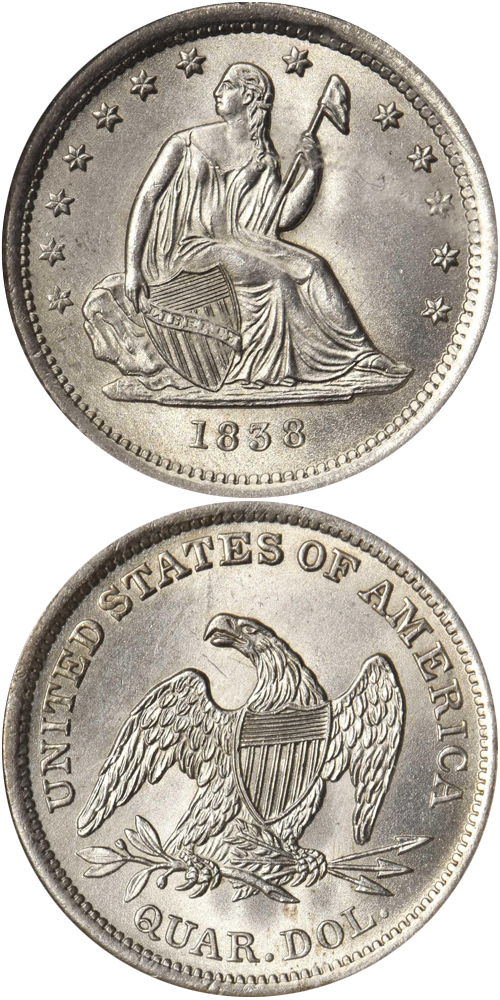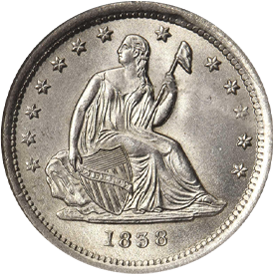Designed by: Christian Gobrecht
Issue Dates: 1838-1853, 1856-1865
Composition: 90% silver, 10% copper
Diameter: 24.3 mm
Weight: 6.68 grams (103.08 grains, 1838 to 1853), 6.22 grams (95.98 grains, 1856 to 1865)
Edge: Reeded
Business Strike Mintage: 46,685,313
Gobrecht's Liberty Seated design made its appearance in the quarter dollar denomination in 1838. Matching other new silver designs of the time, the quarter dollar depicts Miss Liberty seated on a rock, her left hand holding a liberty cap on a pole and her right holding a shield inscribed LIBERTY. Thirteen stars are at the border, and the date is below. The reverse is somewhat similar to the preceding except the denomination is expressed differently. An eagle is perched on an olive branch and holds three arrows. UNITED STATES OF AMERICA is above and the denomination QUAR. DOL. is below. There is no motto on the reverse.
This style was produced from 1838 to early 1853 and again from 1856 through 1865. Early issues lack drapery at Miss Liberty's elbow. From 1853 through 1855 special varieties with arrows at date were made and are different types. The collector has a wide variety of type set possibilities within the range. Although there are a number of scarce and rare dates, there are sufficient common issues that there should be no trouble in obtaining coins graded from Good through Extremely Fine, although it is important to note that Liberty Seated quarters of this era are in general scarcer than half dimes, dimes, or half dollars. AU pieces are scarce, and Uncirculated coins are scarcer yet. Superb Uncirculated coins are rare in all instances. Proofs were distributed to the public beginning in 1858.
Further Reading
The Liberty Seated quarter issues of 1838 and 1839 had no drapery at the elbow, nor did certain (but not all) 1840-O issues have that feature. Other quarters in the series from that point through the end had the drapery feature.
From 1838 through 1853 quarters were produced at Philadelphia and, beginning in 1840, at New Orleans. A number of interesting varieties are listed in reference books today. The 1842 Small Date issue was struck only in Proof condition for inclusion in the few (probably no more than two dozen) presentation Proof sets made for government officials, dignitaries, and numismatists. As most of these sets have long since been broken up, it is believed that no more than a half dozen or so individual 1842 Small Date quarters exist today.
The 1849-O, for which no separate mintage records have ever been published, is scarce in all grades and probably does not exist in MS-65 or better preservation. Numerous other issues within that range, particularly New Orleans coins, are rarities in Mint State, although they have not been appreciated as such.
In late 1982 headlines were made in Numismatic News and in Coin World when a treasure trove of coins was unearthed in New Orleans during excavation on the site of a long-forgotten bank. Apparently certain valuables were secreted there early in the Civil War. A mad scramble ensued, and bystanders either joined in the muddy fray or were treated to the sight of businessmen, secretaries, teachers, and others rooting around in the dirt to look for silver quarters, half dollars, Spanish coins, and other treasures.
As is often the case when treasure troves are discovered, few records were kept, rumors proliferated, exaggerations were the rule, and little factual information could be had. However, from pieces seen or offered to me it is apparent quite a few New Orleans Mint silver pieces of the era came to light, including a number of high-grade Liberty Seated quarters of the 1840s. Most examples showed light degrees of wear and could be classified as AU, but probably as many as a few dozen, distributed over several dates, were MS-60 to MS-63 or finer.
In worn grades Liberty Seated issues exist in approximate proportion to the mintage figures. A number of issues are elusive, with the 1853 (sometimes referred to as "1853/2") without arrows being one of the hardest to find. Surprisingly, several MS-63 or finer pieces exist of this variety.







